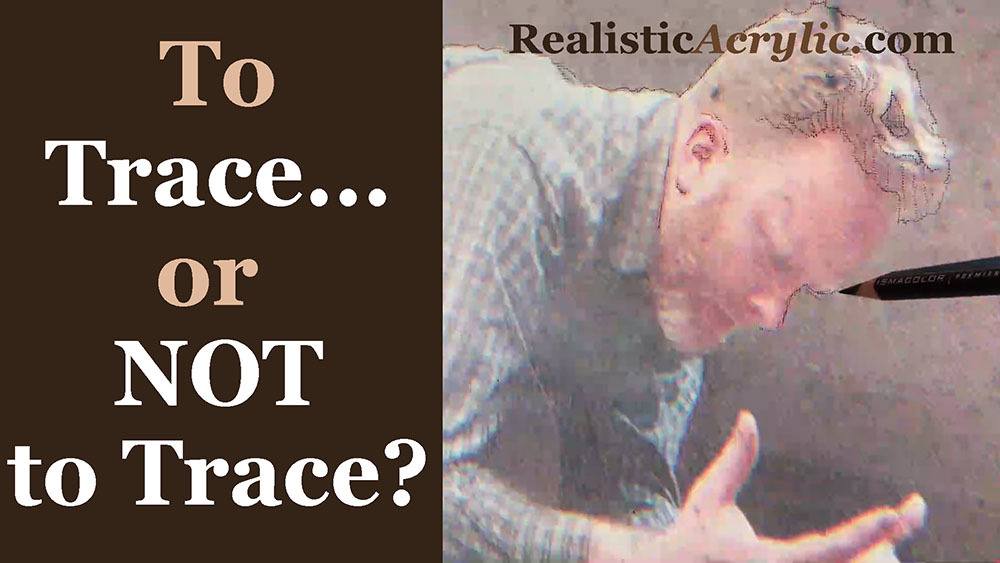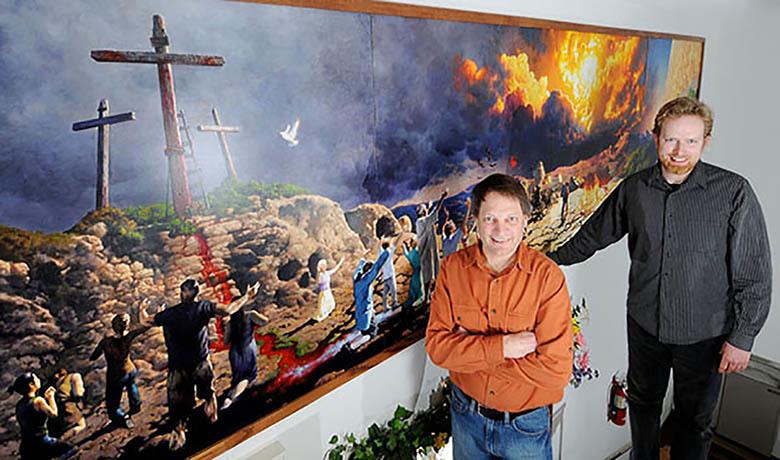- You are here:
- Home »
- Blog »
- Video Tutorial »
- How to Trace? Is it OK to Trace as a Portrait Artist?

How to Trace? Is it OK to Trace as a Portrait Artist?
Let’s address the elephant in the room: tracing as a portrait artist. Is it OK? Is it cheating?
I’m going to answer that question today.
Up until COVID-19 hit, I participated in a Fall studio art tour every year. An artist on the tour, who was also the founder and coordinator for it, had some strong opinions about tracing.
“Matt, tell me you didn’t trace that sketch for the mural project you did.”
“I’m not going to lie,” I told her. “I did use a projector to get the proportions up, and then refine it freehand.”
“How could you do that? What if your client found out?”
“Well, first of all, this project was done for my church, as a gift,” I replied. “And secondly, I would be upfront with them if they asked about my process.”

She chided me in a motherly kind of way, and I listened respectfully and smiled.
This is the first time I ever really thought about the concept of tracing as being a bad thing, at least to this degree. But is it?
I’m going to give you 5 reasons why I believe tracing is OK.
- Tracing saves time. Let’s face it. Drawing freehand, or with a grid is a time-consuming process. You have to measure, re-measure your proportions, and if you lack much drawing experience, often have to settle for eyes that are too large, noses that are unnatural, and mouths that aren’t aligned properly. I have many commissions to do, and so tracing expedites my workflow. I don’t trace all of my portraits, but for some, I choose to do so.
- Tracing helps you get accurate proportions, especially for a large painting. I had always drawn freehand and never even thought of tracing until 1999, when I did mural work with a well-known Florida muralist, Bob Jenny. He had hired me to do a series of murals depicting army medics serving in American wars at some VA hospitals. They were large—two 6′ x 30′ murals. One day, he came by to check on my work. He saw me meticulously sketching a battle scene, freehand. “We’re going to be here for months if you do it that way!” he exclaimed. “Let me show you how to do it.”And he taught me how to use an overhead projector to transfer the design up quickly and effectively.
- Tracing helps you to see distinctions in value. When you trace, especially using a projector, details become blurred and you readily notice differences in value—those distinct shapes that create the planes, the forms we see—whether they are the forehead, nose, cheekbones, or locks of hair. You can trace along the edges of those distinctions. It can be a beneficial exercise to help you in your portrait painting.
- There is historical precedent for tracing. Jan Vermeer reportedly used a camera obscura to project scenes from outside onto his surface to create exact replications of landscapes. So there is so shame. I think we can all appreciate the work of Vermeer. Art historians and art appreciators alike marvel at his skills.
- Tracing is a tool. It can be used like a contractor uses a nail gun to frame a house. The same work could be done by old-fashioned hammer and nail, but the nail-gun will do it faster. Obviously, this metaphor doesn’t translate entirely in terms of portrait painting, but the idea I’m trying to convey is that it’s just a tool.
Now, with all that said, here are some caveats on tracing.
- If you ONLY trace, and never do freehand sketching or use the grid method, your portrait painting skills will suffer. You will either stagnate, or take a very long time to progress past the beginners’ level. I get emails often from artists asking me to help them with skin tones, but because they haven’t put in the time to observe proportions and render them on the canvas, they don’t create realistic value shapes. The result is a portrait that looks falls far short of their goals. Anatomy and values must come first, skin tones after. And freehand sketching is the best way to develop it. I drew freehand for years as a child, before beginning to use acrylic in high school, and the observational skills I learned were priceless. Tracing is not cheating. But if you rely on it too much, it will cheat you, as an artist, of growth. This is why I teach my classes mostly using the grid method. It’s a good middle-of-the-road option between freehand and tracing. It helps artists create a solid sketch, so they can do a portrait they’re proud of without having to spend years getting proficient at freehand sketching. It helps them to see proportions and shapes, and then carry that confidence into their painting process!
- Tracing helps you to quickly establish proportions on your canvas, but it by itself, it’s not enough. The process often omits fine details and nuances that can only be achieved by refining your sketch with freehand sketching. In fact, tracing can flat-out distort your photo reference. In a scene, it totally obliterates the distinction between foreground and background. It can cause areas with lighter value to exceed the proper boundaries. If you want an accurate sketch to work from, you must evaluate your tracing and go back on top of it with more work, to fix mistakes and supply detail that is lacking.
- If you trace, be honest about your process. You are not obligated to tell the whole world, “I traced this!” But if your client or Facebook follower asks, did you do this freehand (most will never ask) be sure to answer them honestly and confidently about your process. If you don’t feel ashamed about it, they won’t think any less of you as an artist. Even with a traced/ projected sketch, it still takes an incredible amount of skill to do the remaining work: selecting colors, mixing them, applying them in the right places, and finishing with detail.
Here is a fun video I did on tracing. I go over a few of the ideas I shared with you above, and I also show you, if you choose to trace, how to do it, using a painting I’m doing right now as an example…
Is it OK to Trace as a Portrait Artist?
What are YOUR thoughts on tracing? Let me know below, in the comments!
- How to Paint Foliage Using the Acrylic Glazing Technique
- How to Trace for an Accurate Portrait Sketch
- How to Paint Realistic Eyes in Your Acrylic Portrait
- How to Add Raw Umber Dark & Ultramarine Blue to Your Portrait
- How to Make Your Own Raw Umber Dark
- How to Paint Realistic Trees & Grass in Your Acrylic
- How to Block In Skin Tone Values Using Glazing Technique
- How to Paint Vibrant Reds in Your Acrylic Portrait
- How to Glaze Background Colors & More Acrylic Portrait
- How to Paint White Clothing in Your Acrylic Portrait
- How to Easily Transition from a Sketch to a Painting
- How to Block In Shading & Skin Tones in Your Acrylic
- How to Build Up Color on Acrylic Pet Portrait
- How to Build Up Form on Clothing with Acrylic
- How to Paint Dark Clothing Using Acrylic Glazing Technique
- How to Paint a 24 x 30 Acrylic With 30 People
- How to Do Smooth Shading with Acrylic
- How to Sketch an Acrylic Portrait with a Grid
Read more about how to paint a portrait that you can surely be proud of!
I’d love to hear your thoughts about this video. Please share it with your friends and family. Let me know if you have any further questions. I’ll greatly help you.
If you’d like to learn more, sign up for my free email tips and video class today.
Learn How to Paint Acrylic Portraits With My Free Mini-Video Course!
Thank you so much for taking the time to read this tutorial and watch the video. That means a lot to me. I hope you find it very helpful in your portrait painting.
Yours for Better Portraits,

P.S. Did you find this post helpful or encouraging? If so, send it on ahead! Let others know with the share buttons below. I’d love to hear your comments. Thank you so much! Also, do you have a question on acrylic portrait painting you’d like answered? Let me kno
